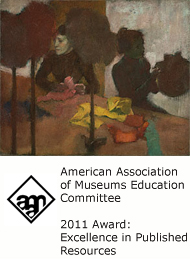Historical Witness, Social Messaging
 |
||
Over the course of history, powerful works of art have depicted examples of social injustice, utilized propagandistic techniques to exert power and sway public opinion, and communicated aspects of current events during times of war, slavery, racial and gender bias, and unfair labor practices.
This curriculum explores the many ways that art can provoke dialogue about the costs and consequences of significant events in U.S. and world history while simultaneously effecting social change and increasing awareness among individuals and governments.
The lessons are grounded in historical contexts surrounding works of art in the Getty Museum's collection, yet connections are made to modern-day events and human struggles as well as to contemporary uses of images to communicate to a wide audience. Such connections to contemporary society allow students to trace common themes in history across time and to comprehend events that took place in the past through studying their counterparts in the present.
The curriculum covers these eight topics:
• Breaking the Chains, Rising Out of Circumstances
• Celebration and Satire
• Depicting Women and Class in a Global Society
• Flawed Democracies, Human Rights
• Land Use and Lawmaking in California
• The Many Different Sides of War
• Putting a Spin on Current Events
• What Is Work and Who Are the Workers?
Each topic is divided into beginning-, intermediate-, and advanced-level activities that act as scaffolds for step-by-step learning. Middle and high school teachers can use less advanced activities to review student understanding of basic principles required for the more complex activities. Beginning-level activities address elementary school standards, intermediate activities address middle school standards, and advanced activities address high school standards. History, social studies, and art teachers are encouraged to collaborate when implementing these lessons in order to share resources and expertise.
This curriculum explores the many ways that art can provoke dialogue about the costs and consequences of significant events in U.S. and world history while simultaneously effecting social change and increasing awareness among individuals and governments.
The lessons are grounded in historical contexts surrounding works of art in the Getty Museum's collection, yet connections are made to modern-day events and human struggles as well as to contemporary uses of images to communicate to a wide audience. Such connections to contemporary society allow students to trace common themes in history across time and to comprehend events that took place in the past through studying their counterparts in the present.
The curriculum covers these eight topics:
• Breaking the Chains, Rising Out of Circumstances
• Celebration and Satire
• Depicting Women and Class in a Global Society
• Flawed Democracies, Human Rights
• Land Use and Lawmaking in California
• The Many Different Sides of War
• Putting a Spin on Current Events
• What Is Work and Who Are the Workers?
Each topic is divided into beginning-, intermediate-, and advanced-level activities that act as scaffolds for step-by-step learning. Middle and high school teachers can use less advanced activities to review student understanding of basic principles required for the more complex activities. Beginning-level activities address elementary school standards, intermediate activities address middle school standards, and advanced activities address high school standards. History, social studies, and art teachers are encouraged to collaborate when implementing these lessons in order to share resources and expertise.